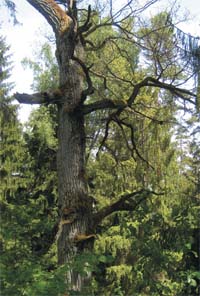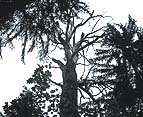 |
We’d come down through the Monterey
Pines in to the trees behind the car park when a clamour of alarmed bird
calls caught our attention. I could see a male Blackbird perched on a branch,
tail held aloft, evidently agitated while a Wren was firing out its machine
gun like rapid call. I thought it might be a squirrel that had alarmed
them so trained the binoculars |
at the foliage. Almost instantly I found I was
looking at two big yellow eyes whose large black pupils were staring back
at me.A big feathered ‘ear’ tuft protruded through the leaves
where a owl sat motionless. Although the ear tufts (they’re not really
ears just feathers) gave it a similar appearance to our most common owl,
the Long eared owl, its huge bulk marked it out as, yes, him again, the
Great Horned Owl. A family pet, there are posters pasted up on trees saying
he had escaped again from his home in Ballybrack over a month before. A
few years ago he had spent a few weeks around Dalkey making startling appearances
on balconies, in back gardens, regularly at Castle Park School and on top
of a garage in Hyde Road. Although evidently well capable of surviving
in the wild he was actually very approachable and you could stroke it’s
feathers without causing it any distress. At the same time any owl should
be treated with respect. Their talons are very powerful, capable in this
bird’s case of killing rabbits, and some species of owls are one
of the few species of wild birds that will actually aggressively attack
humans if they think their nest or chicks are in danger. The Ural Owl is
probably the only bird in European bird field guides whose description
has a warning to be very careful of it during the breeding season since
if you get near its nest it may well attack, going for the eyes with those
powerful talons. One of the most famous owl experts and photographer Eric
Hosking lost his left eye when he was attacked by a tawny owl which gave
the name to his autobiography An Eye for a Bird. But we don’t get
Ural owls in Ireland, none of our native owls are known to be aggressive
to people and this Great Horned Owl was apparently a much loved family
pet who was very good with children but is now not so popular with the
local birdlife. I hope he gets back home.
|
| The last week in May found us in Poland
on a birdwatching trip organised by the South Dublin Branch of Birdwatch
Ireland who took a coachload of people around the east and northeast of
Poland. Passing through lovely countryside, fields filled with wild flowers,
towns and villages with wooden houses and neat gardens was like stepping
back in time. But what I found most impressive and very heartening was
the miles and miles of forest we drove through. And they were forests,
not like the commercial plantations of dark lifeless Sitka spruce that
dominate so much of Wicklow in Poland the conifer woods had Scots Pines
sparingly planted among native Oaks, Limes, Hornbeams and Birch with very
little ground cover (I don’t think we saw a single bramble for the
whole trip) permitting extensive views through the trees and along the
forest floor. But all the vast woods and forests paled into insignificance
beside the Bialowie – a forest which crosses the Belarus border into
North East Poland. This is the last remnants of a vast forest that once
stretched across Europe many centuries ago and it is under very stringent
protection with access to some of the oldest areas only permitted with
a licensed guide. We had hired a official guide and he led us through the
grounds of the old Czar’s palace beautifully landscaped in |
 |
classic English Capability Brown style with vistas
of rolling meadows leading the eye through majestic trees, many of them
hundreds of years old. The track to the protected area of forest led through
a meadow of waist high wild flowers and grasses out of which the rasping
calls of Corncrakes escorted us. We came to the enormous wooden gates and
then we were in the forest. The forest still supports a sizeable number
of European Bison, wild boar, beaver, packs of wolves with at least 15
Lynx holding territory in the forest as well as pine marten, red squirrels,
many other mammals and of course many species of birds including nine species
of woodpecker and several species of owl ranging from the tiny Pygmy Owl
to the formidable Eagle Owl.
|
 |
It was a very calm day and not a breeze
moved the leaves in the trees towering above us. The height of the tree
canopy prevents much sunlight penetrating to the forest floor where only
a small covering of early wild flowers grew. As you’d expect lots
of huge oaks but some of the most impressive trees were huge lime trees
literally twice as big as we’d ever see them here. The only conifers
in this particular forest were native Norwegian Spruce and since theforests
management plan includes no intervention in the natural development of
the forest many of |
these trees have died, usually of natural causes
or old age and stand bare of foliage, waiting to topple whenever their
time comes. The dead trees provide lots of food and nest holes for woodpeckers
and when they do fall they provide lots of nutrition to the forest floor
and home to many species of insects. As our guide commented, when and where
the old trees fall is a constant source of speculation and a vested interest
to him and the other guides since they walk under them most days. I did
wonder about how the forest had fared during the Second World War but thought
it a bit insensitive to ask but then the guide showed us a simple plaque
which was between two graves whose borders were simply marked by interwoven
branches. This was a memorial to local villagers who had been murdered
by Nazis for supporting the resistance fighters who lived in the forest.
But apart from that poignant moment the forest was a heartening place to
visit and it was great to see such a value placed on the unique habitat.
|
| Back to Ireland in the heat wave. Next
morning we were up Killiney Hill, as lovely as anywhere in the warm sunshine!
Unfortunately, like the heat brings flies to a barbecue, the heat brings
drink parties to the hill and we came upon the remains of a marathon drinking
session which ironically are nearly always held in the nicest parts of
the wood as if they’ve planned to find the nicest place to desecrate.
Cans, plastic cups, plastic bags, dozens of bottles, some shattered, strewn
around the smouldering remains of a fire where cans and plastic bottles
smouldered. |
 |
| We filled a discarded bin bag and three plastic
bags with bottles, broken glass and cans before bags and time ran out.
Earlier that morning we had seen a much more positive sight. Three young
ravens on top of the telegraph tower on Dalkey Hill, living proof that
the Dalkey ravens had bred successfully again. Flying with great confidence,
like many young birds their inexperience is only obvious when they come
in to land, crashing on to branches or tottering awkwardly on top of rocks.
|
|



